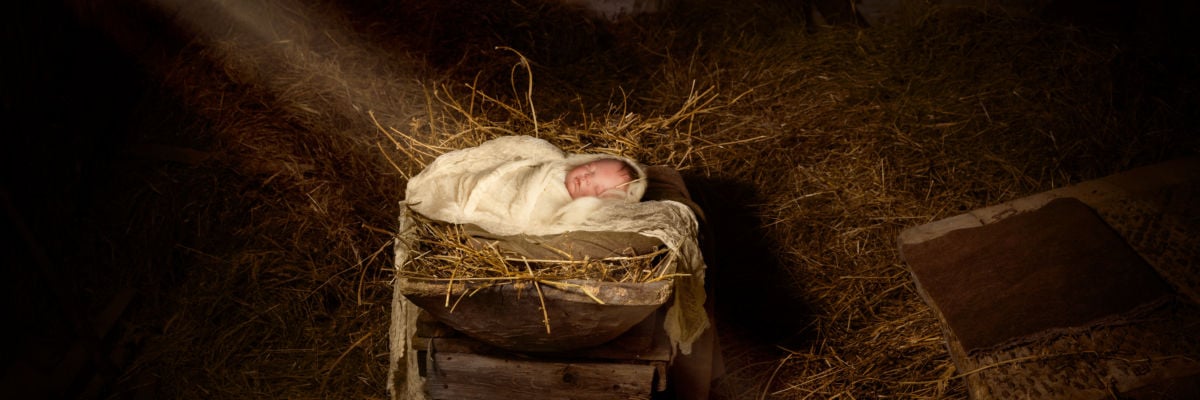
One of my favorite Christmas carols is not one that is usually sung in church. In fact it probably shouldn’t be, at least liturgically. It’s called “The Friendly Beasts.” Maybe you know it:
Jesus our brother, kind and good,
Was humbly born in a stable rude,
And the friendly beasts around him stood:
Jesus our brother, kind and good.
It then goes through the animals—donkey, cow, sheep, and dove—all of which do something to welcome the newborn child.
I am not sure how it happened, but some years ago this song became our go-to kids’ bedtime song. I sang it over and over, every day, for probably a year. And it’s still in the repertoire when one of the little ones asks for a song before bed.
You can imagine, then, my shock and horror when I read an article a few years ago from a biblical scholar informing us that Jesus was not, in fact, born in a stable. This quaint image, the historians tell us, is really just that: a quaint, imaginative picture of Christmas that has more foundation in medieval and modern social conventions than it does in the realities of first-century Palestine.
Where, then, do we get this idea that has so enthralled our cultural imagination? All we have to go on is really that one line from Luke’s gospel: “And [she] laid him in a manger, because there was no place for them in the inn.” We get two clues from that verse: manger, and inn. And we in the modern West know what those things mean: a manger is a feeding trough for animals found in, obviously, a stable or a barn. An inn is a place for travelers. From those two concepts, you pretty quickly get to this classic story of Mary and Joseph being rejected from human society in the busy, overcrowded city, being forced to settle down in a place for animals.
When you start to delve into the historical details, things get a little more complicated. First, the word often translated as “inn” does not mean anything like what we think of as a hotel or even a guest house. It means more like a spare bedroom, maybe even a loft—a space used for extended family and visitors. And this makes a lot more sense, even with the details that we know from Luke.
Joseph and Mary are headed to Bethlehem because it is their ancestral home. It is the seat of their family, which is, by the way, not just any family, but the royal family of Israel. Joseph is a direct lineal descendent of David—as Matthew takes great pains to tell us—and it is unthinkable that he would show up in Bethlehem and not have a place to stay. Even if, by some stretch, he did not know some of his cousins in Bethlehem, all he needed to do was show up at someone’s door and say, “I am Joseph, son of Jacob, son of Matthan, son of Eleazar, of the house of David,” and he would have been promptly welcomed. When Luke says, “There was no room in the inn,” he doesn’t mean that the Hampton Inn, Bethlehem City Center, was full up. He means that there was no dedicated guest space available in the house, and so Joseph and Mary would have been forced to stay in the same room as the family.
And thus we come to the manger. In most first-century Palestinian houses, the family lived in a single room, which was also used for animals. This is not to say that children had to share a bed with goats. The animals were usually held in a lower area near the door, or perhaps in an area fenced off from the family part of the house. And on the edge of that area were the mangers for keeping the animals fed. Rather than being a grand statement about how isolated and rejected Jesus was, the manger in Luke is a practical consequence of overcrowding. Instead of being off on their own, Mary and Joseph were likely so much in the middle of things that they couldn’t avoid the company of others.
But strip away all those other imaginative details, and recall this one detail that we get from Luke’s gospel: a manger.
Surely, the traditions—pious or impious, childish or mature—about Jesus communing with the friendly beasts are actually on to something. Even if he wasn’t isolated from human society, he was put there next to the animals. He was put in an animal feeding place. That rightly inspires the imagination, because if Jesus is who Christians say he was, the incarnate Son of God, there’s reason to think that the animal kingdom might know this in some intuitive way that we, with our minds clouded by sin and evil, cannot.
But it’s not as if he came just to that animal world. We’d be wrong to think of his location in the manger as somehow a rejection of the normal world of human society, because, in point of fact, the manger is the link between the animal world and the human world, between the world of nature and the world of human rationality and civilization.
There’s something beautiful about that image, I think. We speak in the tradition of Jesus joining heaven to earth and earth to heaven, but of course he does much more than that: he joins earth to earth, person to person, thing to thing. He is in every sense the center.
But we’d rather be the center. Or we’d rather the center be right where we are. If you’re a person of wealth and status, it might be comforting to imagine Jesus as being born in the upscale maternity ward of a nice hospital while his family’s domestic staff prepare his perfect nursery back home. If you’re poor, it might be comforting to imagine Jesus born as an outcast in a place isolated from the comforts of social privilege. But the historical Nativity is neither of these things. And lest we take from that that Jesus is obviously just your average middle-class guy who isn’t aware of class, let’s remember that
(1) he was a direct descendent of King David and therefore, technically speaking, royalty;
(2) he was all the same not wealthy, as the Gospels are keen to point out later on; and
(3) being put in a manger at birth was still not a normal thing—the angels in Luke tell the shepherds that that is how they’ll recognize the Lord, which does suggest that there were not likely an assortment of regular babies-lying-in-mangers to be found in first-century Bethlehem.
In other words, Jesus is not an ideal type or a principle of human social organization; he is a real person born into a real situation, with all of its unique complexity.
And if he is the center of all things, he is the center of all things not as an idea, but as a person. His location in the manger is a useful symbol, a powerful symbol, even, but it does not mean that we can say, Oh, I get it now. Jesus joins things together, and move on from Jesus to the idea of joining things together and think everything is okay.
You can’t avoid the specificity of it all. If we want to meet him, as the shepherds did, we cannot go around searching for an idea, for a message; we have to search out the person.
If we’re not supposed to generalize Jesus into a principle, what are we supposed to do?
I, said the cow, all white and red,
I gave him my manger for his bed.
I gave him my hay, to pillow his head.
I, said the cow, all white and red.
Back when we began singing this song at bedtime, my eldest son would basically force us to improvise new verses based on our pets, or on whatever zoo animals he happened to be interested in at the moment. I, said the moose, with antlers large. Eventually we had to give up because the rhyming got too hard.
But sometimes an escape from reality brings us that much closer to what is true. When you think about it, so much of the poetry of Christmas revolves around this theme of putting ourselves—or a whole cast of characters—into the story. Think of Christina Rosetti’s final verse of “In the bleak mid-winter”:
What can I give him, poor as I am?
If I were a shepherd, I would bring a lamb;
If I were a wise man, I would do my part;
Yet what can I give him? Give my heart.
Give my heart! The cow gave her hay, the sheep his wool, the dove its song, the kings their gold and spices. What will you do? You and I, like Jesus, are not principles or ideas, or mere animals, but persons. And Jesus is in the midst of us, calling us to be personal, to be specific, to meet him, to meet God, here in this world.
What will you give? What will you give up? What will you do? How will you meet him and worship him, the Lord, the babe in a manger?



